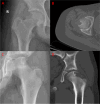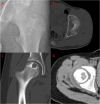Chondroblastoma of the femoral head: curettage without dislocation
- PMID: 39558306
- PMCID: PMC11572398
- DOI: 10.1186/s12893-024-02660-4
Chondroblastoma of the femoral head: curettage without dislocation
Abstract
Background: Chondroblastoma (CBL) of the femoral head is a rare disease, typically encountered in the epiphysis of long bones, with its occurrence in the femoral head being particularly uncommon. The unique location and aggressive nature of this tumor pose substantial challenges in its treatment, leading to ongoing controversies regarding the therapeutic approaches. In this study, we introduce a technique of curettage without surgical dislocation as a treatment option for CBL in this challenging location.
Methods: A total of 6 children diagnosed with chondroblastoma of the femoral head underwent a surgical procedure consisting of curettage, the application of anhydrous alcohol as an adjuvant therapy, followed by bone grafting. The epiphyseal plate status of the femoral head was classified as open, closing, or closed. To evaluate the children's postoperative functional outcome, the Musculoskeletal Tumour Society (MSTS) scoring system was utilized. Additionally, the Lodwick classification was employed to assess the extent of bone destruction. Furthermore, the kappa coefficient was calculated to quantify the level of inter-observers agreement in assessing the status of the epiphyseal plate.
Results: The epiphyseal plate status was closing in two patients and closed in four patients. According to the Lodwick classification, one patient was classified as IA, one as IB, and four as IC. The mean MSTS score was 28. Notably, one patient developed a femoral neck fracture three months post-curettage.
Conclusions: Curettage without surgical dislocation, combined with the use of anhydrous alcohol as an adjuvant therapy, followed by bone grafting, constitutes an effective treatment technique for femoral head chondroblastoma.
Keywords: Anhydrous alcohol; Chondroblastoma; Curettage; Femoral head.
© 2024. The Author(s).
Conflict of interest statement
Figures





Similar articles
-
Modified trapdoor procedures by surgical dislocation approach to treat chondroblastoma of the femoral head.Bone Joint J. 2019 Jun;101-B(6):732-738. doi: 10.1302/0301-620X.101B6.BJJ-2018-1599.R1. Bone Joint J. 2019. PMID: 31154843
-
What are the results using the modified trapdoor procedure to treat chondroblastoma of the femoral head?Clin Orthop Relat Res. 2014 Nov;472(11):3462-7. doi: 10.1007/s11999-014-3771-y. Epub 2014 Aug 13. Clin Orthop Relat Res. 2014. PMID: 25115583 Free PMC article.
-
What Happens to the Articular Surface After Curettage for Epiphyseal Chondroblastoma? A Report on Functional Results, Arthritis, and Arthroplasty.Clin Orthop Relat Res. 2017 Mar;475(3):760-766. doi: 10.1007/s11999-016-4715-5. Clin Orthop Relat Res. 2017. PMID: 26831477 Free PMC article.
-
Surgical treatment of benign osteolytic lesions in the femoral head and neck: a systematic review.BMC Musculoskelet Disord. 2021 Jun 16;22(1):549. doi: 10.1186/s12891-021-04442-y. BMC Musculoskelet Disord. 2021. PMID: 34134687 Free PMC article.
-
Capitate Chondroblastoma: A Case Report and Review of the Literature.Hand (N Y). 2017 Mar;12(2):NP14-NP18. doi: 10.1177/1558944716642762. Epub 2016 Jul 8. Hand (N Y). 2017. PMID: 28344536 Free PMC article. Review.
Cited by
-
Trapdoor Procedure for Benign Bone Lesions in the Femoral Head of Skeletally Immature Children.Orthop Surg. 2025 Jul;17(7):2183-2192. doi: 10.1111/os.70083. Epub 2025 May 29. Orthop Surg. 2025. PMID: 40442572 Free PMC article.
-
Chondroblastoma of the femoral head:current and future therapeutic options.J Bone Oncol. 2025 Jun 15;53:100697. doi: 10.1016/j.jbo.2025.100697. eCollection 2025 Aug. J Bone Oncol. 2025. PMID: 40606223 Free PMC article. Review.
References
-
- Chen W, DiFrancesco LM. Chondroblastoma: an update. Arch Pathol Lab Med. 2017;141:867–71. - PubMed
-
- Hsu CC, Wang JW, Chen CE, Lin JW. Results of curettage and high-speed burring for chondroblastoma of the bone. Chang Gung Med J. 2003;26:761–7. - PubMed
-
- Suneja R, Grimer RJ, Belthur M, Jeys L, Carter SR, Tillman RM, et al. Chondroblastoma of bone: long-term results and functional outcome after intralesional curettage. J Bone Joint Surg Br. 2005;87:974–8. - PubMed
-
- Zekry KM, Yamamoto N, Hayashi K, Takeuchi A, Araki Y, Alkhooly AZA, et al. Surgical treatment of chondroblastoma using extended intralesional curettage with phenol as a local adjuvant. J Orthop Surg (Hong Kong). 2019;27:2309499019861031. - PubMed
MeSH terms
LinkOut - more resources
Full Text Sources
Miscellaneous

